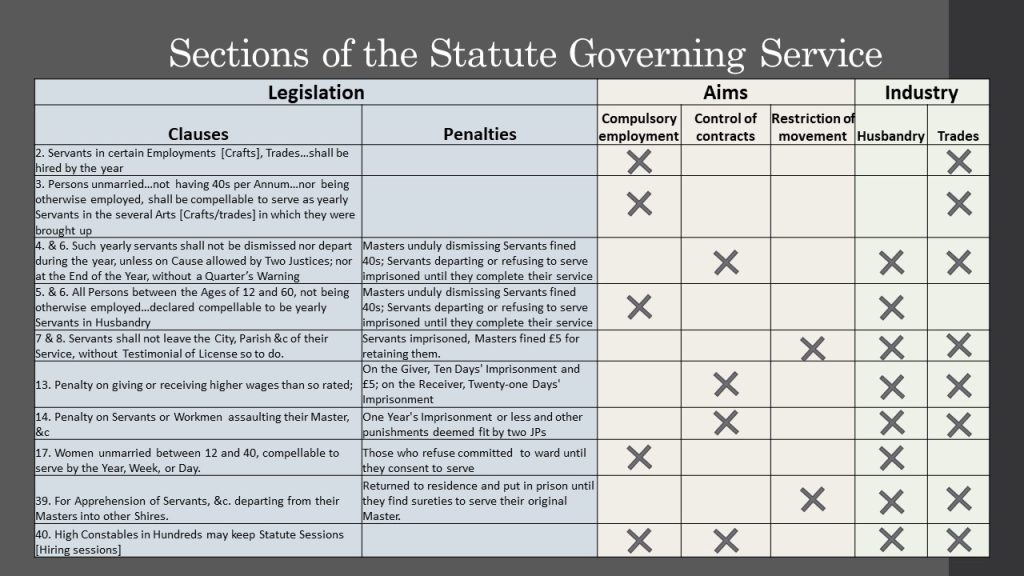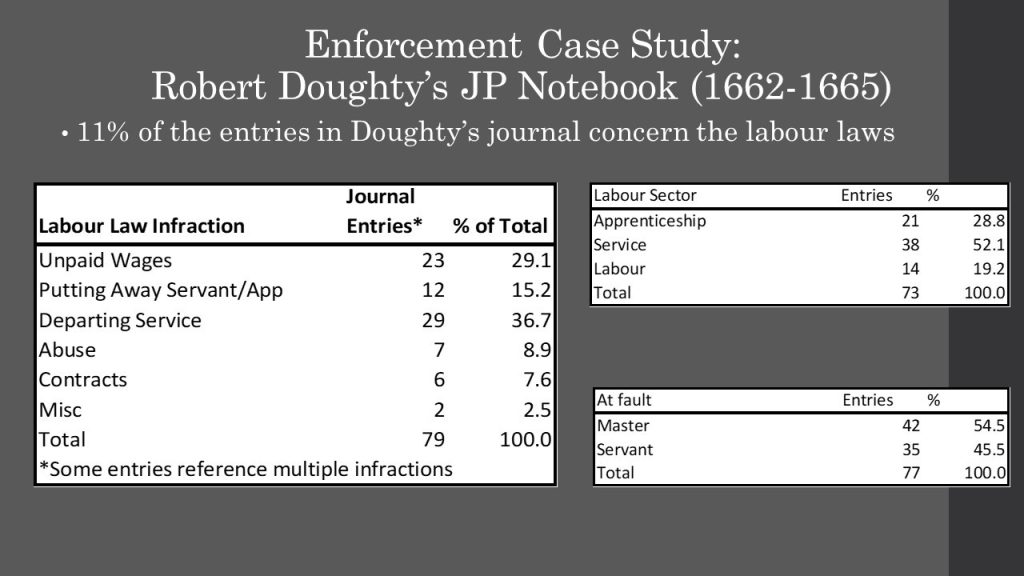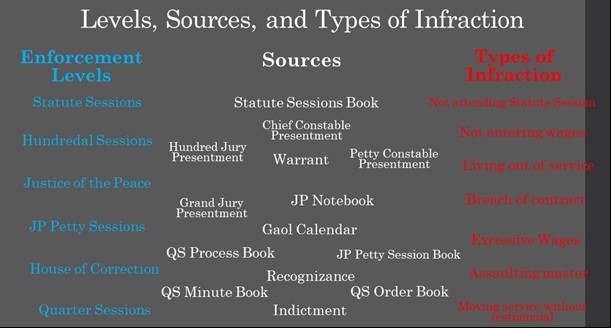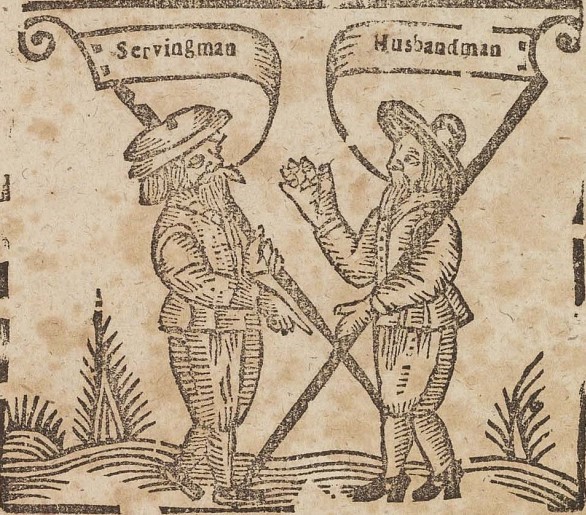TAYLOR AUCOIN
In 1563 the English Parliament passed the ‘Statute of Artificers’ (aka ‘the Statute’), which sought to regulate wage labour and ‘banish idleness, advance husbandry and yield unto the hired person both in time of scarcity and in the time of plenty a convenient proportion of wages’. [1] Such a lofty aim was to be achieved through three main mechanisms, enforced primarily through the county-level criminal courts (quarter sessions):
- Compulsory service for much of the labouring population, with control and oversight of contracts.
- Control of wages through the regular assessment and setting of maximum rates.
- Mandated and regulated apprenticeship amongst craftsmen and merchants.
This sprawling suite of legislation built upon and replaced various labour laws enacted since the Black Death, and it would remain the backbone of the country’s labour code until the early 19th century.
When examined through the lens of ‘freedom or unfreedom’, the Statute appears to underpin an obviously coercive system restricting workers’ agency. Yet, to what extent did this curtailment of freedom extend beyond the law books to reality? This blog post is principally concerned with this question of effective enforcement, a longstanding topic within labour laws historiography.[2] Here I seek to further complicate the debate, by surveying the many levels of labour law enforcement to show just how diffuse mechanisms of enforcement could be, and just how bound the question of ‘effective enforcement’ remains to the survival of certain sources. To make this a more manageable and focused task, I’ll concentrate on those aspects of the Statute which governed service as an institution, as summarised in the table below.

Statute Sessions
The final clause of the Statute (no. 40) laid out the first level of its enforcement: Statute Sessions, also known as Petty Sessions, Hiring Sessions and Chief Constable Sessions. These were convened by the chief constables in their respective hundreds (an ancient subdivision of counties), and had two main functions. Firstly, they acted as public hirings of servants, where all eligible workers and employers were required to attend, so that servants might be retained and the terms of their contracts recorded in the chief constables’ book. Secondly, they reported on labour law infractions; petty constables informed on their respective parishes, and chief constables sent full returns or presentments to the quarter sessions. Prior to the 18th century, such sessions were largely confined to the eastern counties of the country, where they had been in place for centuries. Yet even in such counties, very few sessions’ books or chief constable presentments have survived, leaving a crucial gap in the record of enforcement.[3]
Justice of the Peace
If Statute Sessions and their chief constables were the first port of call for making service contracts, then Justices of the Peace were generally the first for disputes between masters and servants. Landed gentry appointed by the crown to keep the peace through the quarter sessions, Justices (JPs) could also enforce the labour laws outside of court, either on their own, in pairs, or in larger groups. They did so through issuing warrants, examining witnesses, binding offenders over, committing people directly to the house of correction, or simply arbitrating disagreements outside legal formalities. JPs’ powers generally expanded over the 16th and 17th century, so that increasingly labour law enforcement may have been dealt with outside the paper trail of the formal courts. JP’s notebooks, in the very few instances where they survive, show how this was indeed the case; the example below of Robert Doughty of Norfolk is particularly illustrative of the range of business JPs might handle.[4] Interestingly, his adjudication of wage disputes suggests that labour law enforcement did not always favour the employer, and certainly did so less often than more formal court records might imply. [5]

JP Petty Sessions
Beyond the actions of individuals, a 1605 order of the Privy Council empowered JPs to divide up their respective counties into divisions, and then to meet there between each quarter session, to execute certain judicial business. Historians have often interpreted this order as an early step in the gradual and confused development, over the course of the 16th and 17th centuries, of formal JP meetings outside the quarter sessions, later known as Petty Sessions. Counties differed in the speed and manner of their development, but a near total absence of Petty Sessions records in their formative decades hinders any study of the labour laws. For as Norma Landau has shown in her examination of JPs in Kent in the late 17th and 18th centuries, such sessions were often diligently concerned with enforcement of compulsory service, wage rates, and broken contracts.[6]
House of Correction/Bridewell
As the 16th and 17th centuries progressed, the House of Correction became a favoured tool in the JP’s arsenal of labour law enforcement. Houses of Correction (aka Bridewells) developed from the mid-16th century onwards based on the model of Bridewell Prison and workhouse in London, where beggars and vagrants were subject to imprisonment and hard labour. Again, there were regional differences in the gradual implementation of this feature into the system of justice. Lancashire was still struggling to get their first Bridewell built in 1618, while Norfolk had five up and running by the 1650s. [7] Though haphazard in survival, evidence from calendars for the gaol or house of correction, and JP notebooks point to the significance of such ‘workhouses’ for upholding compulsory service in particular.
Quarter Sessions
When we finally reach the Quarter Sessions, we find a plethora of source material yielding evidence of the labour laws in action: presentments and informations, the entering and releasing of bonds, the prosecution of indictments and the collection of fines. Despite this range of sources, there is a heavy bias in the surviving material record (sessions files and minute books), towards indictments and recognizances. These can paint a distorted picture of labour law effectiveness (or lack thereof), since so much enforcement could take place at stages prior to the final step of indictment.
Indeed, this post has tried to show the extent to which enforcement of the English labour laws was diffused through multiple levels of jurisdiction, each of which likewise evolved and varied across region and time. Ideally, we should consider all such levels of enforcement, and utilise all the resultant source-types (summarised in the image below) when grading the ‘effectiveness’ of the labour laws on the ground. Unfortunately, such a range of sources almost never survives for individual counties, and survival of those lower levels of records where much enforcement seems to have taken place is particularly poor. Despite these limitations, patching together case studies, like Doughty’s notebook, can still suggest how aspects of the labour laws, particularly compulsory employment and the control of contracts, were utilised and thereby enforced by magistrates, employers and even employees throughout the period.

Taylor Aucoin is a Postdoctoral Research Fellow at the University of Exeter on the Forms of Labour project. His project research explores the experience of work, as conveyed through witness testimonies in court depositions, as well as the enforcement of labour laws through the quarter session courts of early modern England. Taylor is a cultural and social historian of medieval and early modern Britain, primarily interested in work, play, festivity and Carnival and how these intersected with social relations, identities and politics in the past. His doctoral research on Shrovetide (pre-Lent Carnival) in medieval and early modern Britain is the subject of a forthcoming monograph, and in January 2023 he will begin a new research project, ‘The Contested Ball Game: Football and the Social Value of Sport and Leisure in Britain, c.1400-1800’ as a British Academy Early Career Fellow at the University of Edinburgh.

[1] Statutes of the Realm, pp. 414-422
[2] Literature suggesting weak enforcement: R. H. Tawney, ‘The Assessment of Wages in England by Justices of the Peace’, in W.E. Minchinton (ed.) Wage Regulation in Pre-Industrial England (Newton Abbot, 1972), pp. 37-91; R. K. Kelsall, ‘Wage Regulation under the Statute of Artificers’, in Ibid, pp. 93-254; W.E. Minchinton, ‘Wage Regulation in Pre-Industrial England’, in Ibid, pp. 9-36; Margaret G. Davies, The Enforcement of English Apprenticeship: A Study in Applied Mercantalism, 1563-1642, (Harvard University Press, 1956). Literature suggesting more effective enforcement: Jane Whittle, The Development of Agrarian Capitalism: Land and Labour in Norfolk 1440-1580, (Oxford, 2000), pp. 275-301; Tim Wales, ‘“Living at their own hands”: policing poor households and the young in early modern rural England’, Agricultural History Review, 61:1 (2013), pp. 19-39.
[3] For some examples see Whittle, Agrarian Capitalism, pp. 275-301; F. G. Emmison, Elizabethan Life: Home, Work & Land (Essex Record Office 56; Chelmsford, 1976), pp. 146-164.
[4] Hay and Cray’s survey of such notebooks shows that in the 17th and 18th centuries, between 5-10% of the JPs recorded business related to labour disputes. D. Hay, ‘The Law and Its Uses’, in D. Hay and P. Craven eds, Masters, Servants and Magistrates in Britain and the Empire, 1562-1955 (University of North Carolina Press, 2004), pp. 59-116, at p. 76.
[5] The notebook of Robert Doughty, 1662–1665 ed. J. M. Rosenheim, (Norfolk Record Soc., 54, 1989).
[6] N. Landau, The Justices of the Peace, 1679-1760, (Berkeley, 1984), pp. 209-239.
[7] Proceedings of the Lancashire Justices of the Peace at the Sheriff’s Table during Assizes Week, 1578-1694, ed. B. W. Quintrell, (Record Society of Lancashire and Cheshire 121; Bristol, 1981), p. 11;Norfolk Quarter Sessions Order Book, 1650-1657, ed. D. E. Howell James and Norfolk Record Society, (Norwich, 1955), p. 15.
